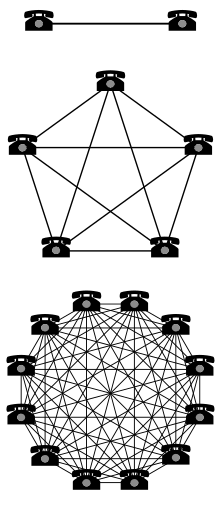This is the first time I've ever heard of this Rob... It's definitely interesting!
Metcalfe's law http://en.wikipedia.org/wiki/Metcalfe%27s_law

Two telephones can make only one connection , five can make 10 connections, and twelve can make 66 connections.
Metcalfe's law states that the value of a telecommunications network is proportional to the square of the number of connected users of the system ( n 2 ). First formulated in this form by George Gilder in 1993, [ 1 ] and attributed to Robert Metcalfe in regard to Ethernet , Metcalfe's law was originally presented, circa 1980, not in terms of users, but rather of "compatible communicating devices" (for example, fax machines, telephones, etc.) [ 2 ] Only more recently with the launch of the Internet did this law carry over to users and networks as its original intent was to describe Ethernet purchases and connections. [ 3 ] The law is also very much related to economics and business management, especially with competitive companies looking to merge with one another.
Contents
|
Network effects
Metcalfe's law characterizes many of the network effects of communication technologies and networks such as the Internet , social networking , and the World Wide Web . Former Chairman of the U.S. Federal Communications Commission Reed Hundt said that this law gives the most understanding to the workings of the Internet. [ 4 ] Metcalfe's Law is related to the fact that the number of unique connections in a network of a number of nodes ( n ) can be expressed mathematically as the triangular number n ( n ? 1)/2, which is proportional to n 2 asymptotically .
The law has often been illustrated using the example of fax machines: a single fax machine is useless, but the value of every fax machine increases with the total number of fax machines in the network, because the total number of people with whom each user may send and receive documents increases. [ 5 ] Likewise, in social networks, the greater number of users with the service, the more valuable the service becomes to the community.
Limitations
In addition to the difficulty of quantifying the "value" of a network, the mathematical justification for Metcalfe's law measures only the potential number of contacts, i.e., the technological side of a network. However the social utility of a network depends upon the number of nodes in contact . If there are language barriers or other reasons why large parts of a network are not in contact with other parts, the effect may be smaller.
Business practicalities
With Metcalfe's Law the way it is described, all companies would theoretically combine with another partner. This would create more users involved in the company both on a consumer and supplier basis. This is not the case however. Much of the time, only companies of equal equity are willing to interconnect with one another. In the case of a larger network or business, and a smaller network or business, the larger feels the smaller one is benefiting on a much larger scale. The larger business gains little in comparison to the small company as the large has already developed a reputation whereas the small company is feeding off their previous success. [ 6 ]
Modified models
Within the context of social networks, many, including Metcalfe himself, have proposed modified models using ( n × log n ) proportionality rather than n 2 proportionality. [ 7 ] Reed and Odlyzko have sought out possible relationships to Metcalfe's Law in terms of describing the relationship of a network and one can read about how those are related. [ 8 ]
